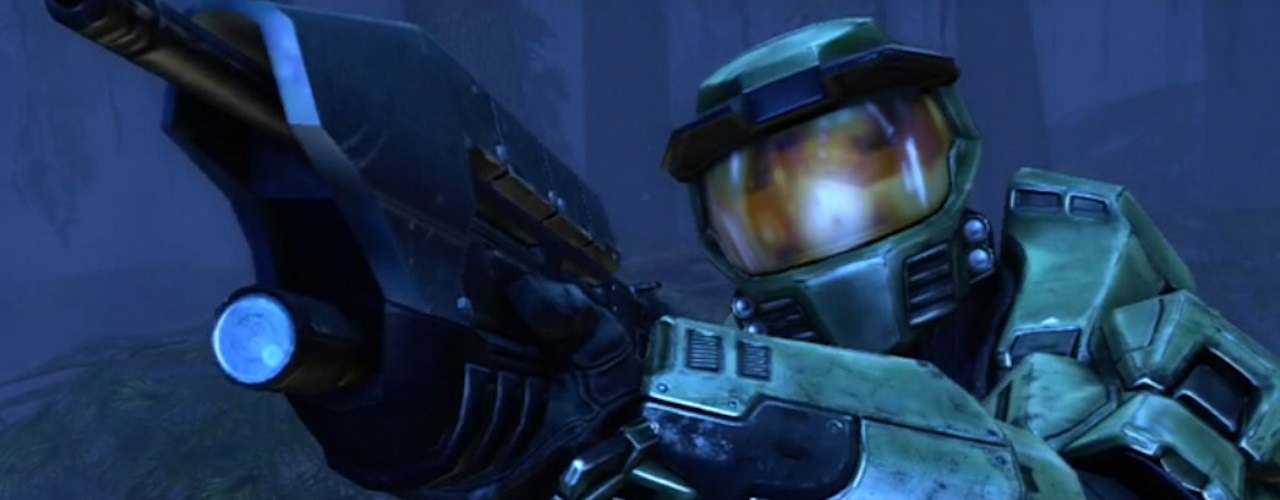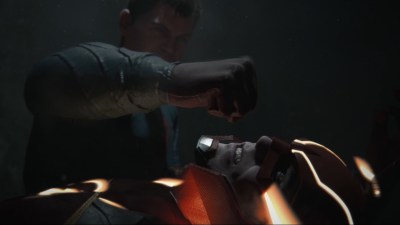“Cortana, all I need to know is: did we lose them?”
“I think we both know the answer to that.”
Few games grab hold of you the way Bungie’s Halo: Combat Evolved does. From the opening shot of the ineffably massive titular ringworld, you feel sucked into an alien world enormous in scope - if narrow in focus.
It’s an almost biblical opening—two arks lost in the empty sea of space. One of these is The Pillar of Autumn, the best ship in her fleet, escaping a devastating battle which has hamstrung humanity’s fledgling interstellar fleet. Onboard is the Master Chief, the last of his kind - a genetically enhanced and cybernetically-augmented super-soldier, schooled from youth in the art of killing.
The other ark is the Halo itself, a huge artificial world built unknown millennia ago by a long-dead race known only by the moniker given to them by the Covenant—Forerunner. Whether Halo is the ark built to keep the horrors of the universe in or out, the player has to decide for themselves.
Arrayed against you is The Covenant, a nation of alien races bound together by the words of their prophets, who view humanity is an affront to their gods, worthy only of total obliteration. The Covenant believe that Halo is a weapon of unimaginable power—one that could cleanse humanity from the galaxy in a single blow.
So the stakes are high, but how does the gameplay hold up in a game that is nearly thirteen years old?
Surprisingly well, actually. Few games get the pace and rhythm of combat down as well as the original Halo does. Whether it’s dropping an Elite over a massive distance with a carefully-aimed sniper rifle slug, or spraying a mass of machinegun fire into a horde of Grunts and Jackals, Halo makes combat challenging and satisfying at any range. Closing in on some of the tougher enemies - Hunters and Elites - your one-on-one battle actually turns into something of a dance. You’ll burst of assault rifle fire to drop their shields, then rush in to stagger him with the butt of your gun, before backpedalling to avoid their counterswing and put three pistol rounds in their head to finish him off. It’s a fluid, dynamic form of combat that never gets old.
This is mostly due to one aspect which has changed a great deal thanks to the rise of Call of Duty-esque shooters - Halo’s enemies are varied. While on the easier settings you can rush straight into a pack of Covenant with your assault rifle blazing and grenades exploding - and still hope to come out alive at the other end of it - doing so on Heroic or (*twitch*) Legendary difficulties will end up with your corpse beneath an alien boot.
It’s all underscored by the excellent soundtrack provided by Marty O’Donnell, who sadly left Bungie this year. Halo’s score succeeds on a technical level- it genuinely moves your emotions, whether with a somber string piece before the approach of night and the game’s climax, or a jaunty adventure tune as you rush the Covenant’s positions on a beach. More importantly, it never loses pace. Because of the way O’Donnell was able to cue his musical changes as the player completed specific points in-game, the music becomes a part of that rhythmic dance that makes Halo’s action so original.
In essence, that’s probably the best part of replaying the original Halo—the legacy that it has left on modern shooters. In 2001, console first-person shooters simply weren’t what we think of them today. Oh sure, there was GoldenEye for the N64 back in 1997, and Timesplitters for the PS2 in 2000, but it would be remiss to say that either was as genre-defining as Halo.
Take Halo’s recharging energy shields. Instead of watching your health points slowly tick away over the course of several gunfights, or scouring the battlefield for missed healthpacks, you could find a corner to hide and let your shields regenerate. Managing your health suddenly felt like strategy, not a scavenger hunt. The next time your health regenerates in Call of Duty, thank Bungie.
Likewise, the game’s restriction on your arsenal, which sees you limited to carrying only two weapons, feels downright terrifying at times. For gamers used to toting around three assault rifles, an SMG, a rocket launcher, and a pistol (because, oh well, I may need it, you know?), restricting us to two guns put us in a tactical bind. Well sure, you can bring the rocket launcher to take out that tank, but your sniper rifle is going to be fairly useless if an Elite sneaks up on you so…
What Halo managed to do was make in-depth, story-driven first person shooters a desirable medium for console gaming. A lot of console shooters of the same time feel downright arcade-like in comparison. It took Halo to convince the gaming community that yes, console shooters could and should be as mechanically and narratively complex as their PC counterparts.
It’s funny then that Halo was never intended to be the killer-app of the original Xbox. When it was conceived in the late 1990’s, Halo was originally designed as a real-time strategy game for the Mac, intended as a sci-fi counterpart to Bungie’s Myth series. Eventually, it became a third-person shooter. It took Microsoft’s game division buying out Bungie for Halo to become an Xbox-exclusive FPS and the juggernaut we all know today.
Occasionally, the game still shows you its strategy game roots—climbing into a vehicle zooms you out of the Chief’s helmet for a third-person view, and the open battles that pit multiple vehicles against one another are some of the best in the game. It’s another piece of the puzzle that Halo manages to get right—rather than feeling like a set piece to get from section to section, vehicle battles feel intense and incredibly liberating. Plus, the Covenant’s Ghosts and Banshees are just so bonkers fun to zip around in.
Sad then, that in the latter half of the game, vehicle battles are few and far between, with the campaign descending into long tracts of intense corridor battles.
That’s also a shame because Halo’s drawn-out battles seem to merely bookend the main points of the story, rather than propelling them forward. With the exception of the game’s climax, there are only a few key moments in actual missions that seem to strike at the key themes of the game.
In the opening battle, as the Autumn falls from the sky, and Covenant boarding parties slaughter crewmembers cowering in fear; you find a poster hanging in the ship’s mess hall. It’s simple really—a picture of earth rising as seen from the moon, a photo snapped during the lunar landings of the 1960s. In Halo’s time, that photograph would seem as distant as Leonardo Da Vinci’s sketches are to us today.
The inscription reads simply, “Fight for her.”
Funny, because Halo doesn’t really show us why earth is worth fighting for. Yes, there’s a primordial fear that kicks in when the Covenant blow the door open on the Chief’s cryo bay (“It looks like the Covenant wanted to catch you napping,” Cortana whispers ghoulishly), but there’s very little counterpoint to the Covenant’s holy war on humankind. Through the Master Chief’s eyes, we don’t really see a whole lot of humanity in Halo. Besides Cortana’s at-times reassuring voice in your ear (something that’s eerily missing in the first mission in which you encounter The Flood), you’re mostly on your own, save for a few Marines who show up to fight alongside you from time to time.
Take the Chief himself—a super soldier kidnapped by the military at a young age, raised in isolation from society only in the art of killing. They call them Spartans. But as was once asked of the ancient state of Sparta, is what the Master Chief fights for really worth preserving? It’s a question that’s never raised directly in the game. In a way, that’s more authentic to the Master Chief’s life—your place is not to question the how or the why, but simply to follow orders.
In retrospect, that’s one of the greatest shortcomings we felt replaying Halo. It raises so many deep questions about the nature of humanity’s existence in the galaxy, yet ultimately strays far away from them, in order to focus on a superhero story. Because of that, it’s hard to feel the emotional impact Halo wants us to feel. Of course Spartan 117 will rise to great things - he was all but bred for it.
There are a few other nitpicks—the voice acting sounds much more wooden now, the Flood remain just as irritating as ever, and the less said about a level called “The Library,” the better [Editor’s note - I still have nightmares about that level].
Ultimately, we found ourselves connecting not with the Master Chief, but with Cortana. As the Autumn disintegrates around her, and Covenant forces storm the ship’s hallways, she takes one last mournful look around, closes her eyes and says: “Yank me.” She’s placed into the skull of a flesh-and-blood super-soldier who could die at any moment.
Despite all of your feats of derring-do throughout the campaign, that’s the greatest moment of bravery in the entire game.
Halo: Combat Evolved revolutionized the FPS genre. Its impact is still keenly felt today, and it remains just as playable now as it was at the time of its original release. Simply put, aside from a couple of minor flaws made more apparent going back to it now, it’s a masterclass of game design that deserves to be played by any self-respecting gamer.


